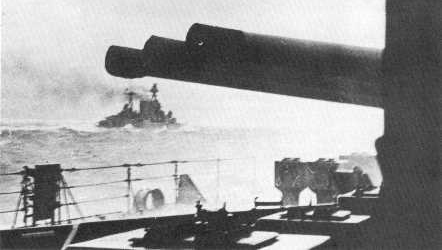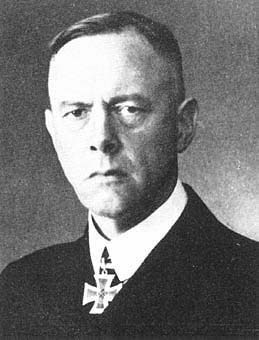I Was There! - We Helped in the Sinking of the Bismarck
The War Illustrated, Volume 4, No. 95, Page 645, June 27, 1941.
The terrible punishment which the Bismarck withstood before she was finally torpedoed and the rescue of a hundred or so survivors from the great German warship are described by British naval officers and men who were "in at the kill".
An able seaman, describing the action with the Bismarck, said: "We pumped everything we had into her. She withstood appalling punishment and we were astonished that any ship could remain afloat in such fire."
We counted over 300 hits with our 8-in. shells. They killed many of the Bismarck complement, but still her guns replied. Bismarck gunners fired from individual control long after central controls were obviously wrecked.
An officer said:
She gave no sign of surrender and kept her battle colours flying and so our firing had to be continued. This was not pleasant.
The Bismarck was still firing in a desultory way when the Dorsetshire closed in to dispatch her by torpedo. But her salvos were whistling harmlessly overhead.
You could see that she was terribly distressed – on fire from stem to stern – flames on the forecastle, amidships, and on the quarter-deck. Dense smoke clouds rolled away, and her sides glowed red-hot as if she were a furnace inside.
An engineer then took up the tale:
We were determined that we would get her, and the engines took it wonderfully.
Down below men were waiting for the signal that would tell us that we had found the Bismarck. When it came, and our guns opened fire, there were cheers. We grinned at one another and said, "Let her have it."
And we did. Some of us were allowed on deck to see the end. When I first saw the Bismarck she was ablaze, and smoke was pouring from her over the tops of her masts. We could see salvo after salvo of shells bursting in her. Every time the guns fired men were waving their hats and shouting: "Give it to 'em", and cheering.
Then torpedoes finished the job. One burst on the stern. Steelwork and stanchions were hurled high above the masts. And men were hurled with them. She went down slowly, a blazing hulk.
A German gunnery officer, who was among those rescued, asked to send a message to the commander-in-chief of the action. It was this: "Your shooting was deadly. You knocked 17 bells out of us."
A British petty officer aboard the ship which brought the German prisoners back said: They were all dazed and looked "punch drunk". They said they had had "hell" from our ships, and most of them had bruises from being knocked about by the poundings and direct hits.
The final moments of the stricken German warship were described by another officer.
He said:
As the Bismarck heeled to port and slowly went down, we could suddenly see all over the hull hundreds of black dots. They were human beings, making a last effort to avoid death. As the vessel heeled over further the dots moved along the hull – anywhere out of reach of the water. The vessel took a last plunge and sank foremost, and the dots were seen in the water.
It was quite impossible to lower any boats in the heavy seas, and all we could do was to throw out long grasslines, which float on the surface, for survivors to grasp. We saved quite a number, but while engaged in this work we received warning that there were submarines in the vicinity and we must get under way.
At one time there were scores of men strung out along two long ropes, striving to get alongside. The waves were tossing them high out of the water and then plunging them into the depths.
Some were half-naked. Their faces were streaked with oil, and when they reached the vessel many were so exhausted that they could not manage the final climb. Every now and then a man halfway up the rope would collapse and carry two or three of his comrades beneath him into the water.
Those we could haul aboard had their knuckles clenched and bleeding. They were frozen with cold and dropped like logs to the deck. Within a few minutes they were wrapped in blankets and bedding and they actually fell asleep as they talked to us below deck.
The lucky ones had very little to say for themselves. They were obviously grateful for all we were doing for them and told us they had had neither food nor sleep for four days.
There was no gloating over the sinking of the Hood, but they seem to take a curious pride in the fact that so many of our vessels had been called out to put paid to the Bismarck.
Previous and next article from The Bismarck and The Hood
'Closer, Get Closer Yet to the Bismarck!'
From 8.30 on the evening of May 26 until it was all over at about noon the next day – until, that is, the Bismarck had been fought to a finish and sent to the bottom – the officer whose story we g
I Was There! - We Fired the Torpedoes that Finished Her
When the chase of the Bismarck was ended and her guns were silenced, she still had to be sunk by torpedoes from the cruiser Dorsetshire, and here is the story of Lieut.-Commander G. R. Carver who fire
Previous and next article from I Was There!
I Was There! - I Saw One Vast Explosion - The Hood Had Gone
The end of the 'mighty Hood' was described as an almost unbelievable nightmare by Reuter's special correspondent, who was on the bridge of one of our warships when the Hood went down with her guns sti
I Was There! - We Fired the Torpedoes that Finished Her
When the chase of the Bismarck was ended and her guns were silenced, she still had to be sunk by torpedoes from the cruiser Dorsetshire, and here is the story of Lieut.-Commander G. R. Carver who fire
Index
Previous article
'Closer, Get Closer Yet to the Bismarck!'
From 8.30 on the evening of May 26 until it was all over at about noon the next day – until, that is, the Bismarck had been fought to a finish and sent to the bottom – the officer whose story we g
Next article
I Was There! - We Fired the Torpedoes that Finished Her
When the chase of the Bismarck was ended and her guns were silenced, she still had to be sunk by torpedoes from the cruiser Dorsetshire, and here is the story of Lieut.-Commander G. R. Carver who fire





